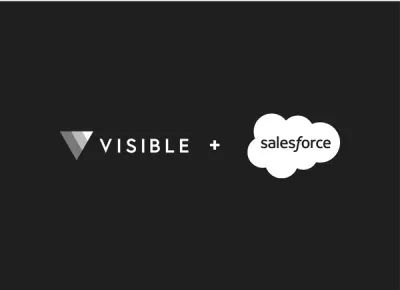Blog
Visible Blog
Resources to support ambitious founders and the investors who back them.
All
Fundraising Metrics and data Product Updates Operations Hiring & Talent Reporting Customer Stories

founders
Fundraising
Ready to Make the Jump from Seed to Series A? Think About These 3 Things.
Raising a Seed round is an incredible accomplishment. For many startups, it’s also the start of a long journey. As more companies get funded at the Seed stage, the competition for Series A capital is growing. In fact, if you are lucky enough to raise a Seed round, your chance of raising a second round is roughly 48%.
Outside of the essentials, like finding product-market fit, scaling revenue, and building a repeatable customer acquisition process, there are plenty of other important things to consider as you get ready to raise a Series A. We’ve laid out 3 of them below.
Tracking Metrics & Financial Planning
David Cummings, investor and company founder, has found that most Seed stage founders don’t track enough metrics on a weekly basis. Having a grasp of key financials and metrics will become vital when courting potential investors past the Seed stage. David suggest starting with the 9 metrics below:
Cash on hand
Weekly burn rate
Monthly recurring revenue
New customers
Lost customers
Marketing qualified leads
Sales demos
Active sales opportunities
Customer net promoter score (NPS)
To make things easier, we’ve turned those 9 metrics into a Google Sheet template you can access here.
Building the Team
Building a strong team is arguably just as important as your initial product and customer acquisition process, as it’s often a key factor investors look at when deciding to invest. As Mark Suster, Founder of Upfront Ventures, puts it, “about 70% of my investment decision of an early-stage company is the team. My rationale is simple: everything goes wrong and only great teams can respond to competitors, markets, funding environments, staff departures, PR disasters and the like.”
Having a small team that covers every major function of a business allows Seed stage companies to iterate quickly while staying capital efficient. As the team continues to grow, the fingerprints of these original team members will be all over the company culture. Not only does a strong team increase your likelihood of raising capital, the early days of hiring are a blueprint for your company culture and structure as you grow.
Engaging Outside Stakeholders
Seed stage founders are pulled in every conceivable direction. On top of building a product, building a team, and creating a repeatable sales process, founders at the Seed stage must also manage their outside stakeholders—both initial investors and the ones they hope to bring on board.
As Ari Newman, Partner at Techstars, says, “Financing is not a dot, it is a line and it is part of your job as a founder and a business leader to keep the capital coming in.”
Engaging potential investors can often draw you away from your day-to-day tasks, so it is important to have a clear process in place, just as you would with a marketing or sales lead. Courting potential investors can’t be a founder’s full time job, so adding process and structure will help protect your time.
For founders who are ready to fundraise, we built a Fundraise Tracking Tool, which helps ensure you can track your prospective investors as simply as possible. Once you have them organized, sending a quick email update every month or so will pay dividends as you get deeper in the fundraising process.
The move from Seed to Series A isn’t an easy one. It requires founders, and the teams behind them, to level up quickly. Paying attention to the above items will help ensure you and your team are set up for fundraising success.
Ready to start nurturing potential investors as you ramp up for a Series A fundraise? Start a Visible trial to send quick and beautiful investor updates here.

founders
Metrics and data
Product Updates
Salesforce Updates – Contacts & Accounts
Contact and Account Objects in Salesforce
The Visible product team just updated our Salesforce Integration. We now support the Contacts and Accounts objects in addition to the already existing Leads and Opportunities objects.
If you need a refresher on Salesforce, you can read more in our knowledge base. Contact us to send us any feedback or questions.
Up & to the right,
-Mike & The Visible Team.

founders
Operations
Themes, Not Goals – What Most Startup Leaders Get Wrong About Annual Planning
Business Planning for the New Year
It’s resolution season, which means many of us are making declarations about how many books we’ll read or how many pounds we’ll lose this year. The ball descends on December 31, and on January 1st—or maybe January 2nd, depending on our hangover level—we set out to make our resolutions a reality.
Here’s a stat that isn’t too encouraging: 80% of those resolutions will fail by February. It’s so bad that some psychologists actually suggest starting your resolutions on February 1. A major contributor to that failure rate is the lofty nature of most resolution goals. Goals are best when they’re broken down into smaller steps that are more attainable and achievable.
Instead of setting out to read 25 books this year, for instance, it’s better to aim at reading 2 books a month. Or—even better—read for 20 minutes every weekday. The end result is about the same, but the path you take to get there has incremental steps that make the goal easier to accomplish.
So what does this have to do with annual planning? Well, if you’re doing it right, you’ve already set your business goals for 2019. But, if closing out Q4 and the blur of holidays got in the way, you may be sitting down this week or next to write out your 2019 goals. And my advice is: don’t.
What I mean is, don’t try to write lofty, year-long goals. For many of the same reasons that most resolutions fail, most businesses miss the mark on their annual goals by year’s end. In fact, businesses fare even worse than resolution-writers: 90% of senior executives told The Economist they fall short of annual goals.
This is especially true in the startup world, where the rapid pace of change means the goals you have today may not even be relevant six months from now.
So instead of focusing on big annual goals, focus on themes. What themes will drive the focus of your business this year? Themes should align with your overall vision, and can be anything that is important to where you want to go. You want something that isn’t so vague that it’s meaningless, but also isn’t so specific that it’s essentially a goal with a different name.
One of the current themes here at Visible is “Time to Value.” We’re asking ourselves how we can ensure that we are having a positive impact on our customers’ businesses as soon as they start using the product.
Once you have your themes, then you can start creating monthly and quarterly goals that line up with them. Themes, then, become the lenses through which you can prioritize your efforts. If an initiative doesn’t line up with one of your themes for the year, you’ll reevaluate whether it’s really worth doing. Our “Time to Value” theme is informing everything from our product roadmap to our marketing efforts.
So, instead of setting big annual goals that you aren’t likely to reach anyway, consider choosing themes instead. If you choose them well, they’ll last a whole lot longer than your New Year’s resolutions do.
Related Resources: How to Write a Business Plan For Your Startup

founders
Fundraising
An Update Template for Kicking Off Your Fundraise
Leveraging your existing network and investors is a great way to kick off a new fundraise. Below is a quick template to share with your current investors announcing your fundraise and asking for introduction to other prospective investors.

founders
Reporting
Powderkeg Podcast: Mike Preuss and David Hall on Fundraising and Stakeholder Reporting
In the opening episode of Season 2 of the Powderkeg podcast, Mike Preuss, our CEO, and David Hall of Rise of Rest discuss fundraising between the coasts and how startups can leverage stakeholder reporting to power their business.
In this episode with David Hall and Mike Preuss, you’ll learn:
Key similarities and differences between non-coastal tech hubs (9:17).
An experienced investor’s high-level work and life advice for entrepreneurs (15:46).
The benefits that thorough stakeholder reporting can provide for every startup (22:51).
How to build a talented team and loyal customer base between the coasts (33:38).
Proven strategies for nurturing healthy founder-investor relationships(37:33).
How founders and investors should approach fundraising in non-coastal cities(49:16).
Give it a listen below or using this link. Enjoy!

founders
Fundraising
5 Questions to Answer Before Your First Meeting With an Investor
“How should I prepare for an investor pitch?”
This is a question we hear a lot, both from first-time entrepreneurs and from founders who have raised before. There is no shortage of advice available on how to prep for a pitch meeting.
Here’s the problem: if you’re asking that question at the pitch stage, you’re already too late. Most of the time, your first meeting with an investor isn’t a pitch. Instead, it’s a coffee, or a cocktail, or an introduction at an event. Often, it’s not a meeting at all—it’s an email conversation.
You know the saying, “you only get chance to make a first impression?” This is especially true for investors. While there’s an awful lot of emphasis put on preparing for a pitch, an investor is going to form opinions about you based on your first interaction, well before the pitch takes place.
Here are 5 questions you should answer before that first interaction to help make sure your first impression is a good one.
What do they invest in?
This is an easy one. You need to make sure the business you’re pitching is in line with the type of business the investor likes to invest in. If an investor only funds B2B SaaS products, don’t try to pitch her on your mobile game company. Investors often like to get involved in industries and markets they understand, which is why most investor portfolio companies share a common thread. Make sure you understand what that thread is for every investor you talk to.
How do they invest?
This question comes with several straightforward sub-questions. What is their typical check size? Do they like to lead rounds, or simply participate? How hands-on do they like to be? Knowing an investor’s MO for the practical details of an investment will help you plan your raise and ensure you’re not wasting each other’s time.
You can start to figure this out by doing a little digging on Crunchbase, reading some press releases, and asking around.
What is their background?
Even if you’re talking to a large VC, you need to understand the individual(s) you’ll be working with. What about their background or experience suggests they could add value to your business? Have they worked with a particular audience or vertical that lines up with someone your business helps? Did you go to the same college?
Investors want to know that you’re not looking to get funded by anyone with a checkbook. Being able to make personal connections, or speak to why you want them involved, will help you catch their interest and start building a relationship.
What do they care about?
Answering this question will do two things. First, it’ll help you determine whether or not a particular investor will be a good fit for your company. We believe you should do due diligence on every investor you bring on board, and this is a good early step toward that goal. Second, it will help you know what to emphasize about your company that will catch their interest. Different investors focus on different things. While some may care about the founding team or the long-term vision, others are more concerned with revenue growth or the total addressable market.
Browsing an investor’s public channels, especially things like Twitter, Medium, Quora, and interviews, is a great place to start.
What do you want?
This is probably the most important question to answer before meeting an investor: what is it you want from them? Even if an investor is interested in your company, they need something to respond to. It’s best to not only have a clear ask in mind, but to also understand what alternative options they might offer (and know which of those options would be acceptable to you).
If you can answer each of these questions before you meet with an investor, you’ll not only make a good first impression, but you’ll put yourself in a much better position to get the outcome you want.
Research thousands of investors with Visible Connect:

founders
Hiring & Talent
Operations
Operations
The Friday Note Challenge
If you are a CEO or other company leader, I have a challenge for you: spend the next 8 weeks writing Friday notes to your team.
You don’t have to send them on Fridays, and they don’t actually have to be written—I’ve seen video updates work very well, too—but you do have to send one to all of your employees, every week, for the next 8 weeks.
If you haven’t done this kind of thing before, I guarantee you’ll be pleased with the results. Ben Horowitz wrote that “perhaps the CEO’s most important operational responsibility is designing and implementing the communication architecture for her company.”
Put another way, the CEO sets the tone for company communication. If you communicate intentionally, openly, and predictably, odds are the rest of your team will, too.
What’s in a note?
A Friday Note can be just that: a note. It doesn’t need to include a in-depth report on company progress or deep philosophical insight. In fact, I’d argue an approach like that could be counter-productive. Instead, share what’s at the top of your mind for the week and why, plus some words of encouragement or additional thoughts. What are you excited about? Where would you like to see improvement? What have you been reading lately?
If you’re sending the note via email, keep it under a page. If it’s a video, two minutes or less. Your note should be easy to digest. If you have additional thoughts, save them for the following week.
Most importantly, take a tone that is as personal as you’re comfortable with. Your team likely gets enough official communication from you and other org leaders, so something more conversational will be refreshing.
What you’ll get in return
It’s easy to forget that with the title of CEO comes a degree of unapproachability. The larger and older your company, the more this is true. A weekly note to the entire team, presented without much varnish, helps you connect with your employees on a more human level than they may be used to.
In a previous role, I worked with the CEO to compose Friday notes for the team’s ~120 employees. He got responses every week. Some were straightforward, to the tune of “thanks for writing this!” but others offered more, like an employee’s thoughts on the subject at hand, or even questions or comments about unrelated matters. Either way, the note started a dialogue that wouldn’t have happened otherwise.
Finally, a weekly note gives you a chance to evangelize your vision. Your team may have heard it at an annual All-Hands or in a quarterly call, but supporting that vision with regular reminders is a great way to ensure that everyone keeps working toward it.
If you need help getting started, we have a great weekly note template in our resources section. Otherwise, just give it a shot this week and see what happens. I promise it’ll be worth your time.

founders
Fundraising
Investor Due Diligence: The Definitive Checklist to Secure a Successful Partnership
You can look at adding an investor to your company in one of two ways; simply a source of capital, or a partner to help you grow your business. As Sangram Vajre, Founder of Terminus, puts it, “Finding a VC firm is almost like finding a co-founder. Any due diligence that you would do to add a co-founder you should do when adding a VC partner.”
If you opt to find a VC that you can count on to add value outside of capital, it is your job as a founder to ensure you’re adding the proper partner. Due diligence is a part of the funding process that all founders are expected to complete. You can flip this process on its head by asking the same of your potential investors.
Related resource: Startup Due Diligence: What Every Founder Needs to Prepare For
While it does not need to be a formal process, you can follow the investor due diligence checklist below to confirm you can rely on your new investors as a business partner:
Tell them what you’re up to. Be transparent.
The key to a strong relationship with any business partner starts with open and honest communication. To get things started on the right foot, you’ll want to be transparent as possible with potential investors that you are performing due diligence.
As an added bonus, if they’re helpful and open to the idea, that is probably a good sign of future communication, transparency, and help you’ll receive.
A quick Google search.
As most research goes, a quick Google search is a great place to start. Check out their LinkedIn, Twitter, Crunchbase, and other social profiles. Ideally, most of this research would be done before you’ve emailed a potential investor, but here are a couple of simple things to keep in mind:
Location – Where are you located? Do you need local investors? Or maybe you are looking for connections and networks in strategic geographies.
Industry Focus – What type of company are you? Where should your future investors/partners be focused? e.g. If you’re a B2B SaaS company don’t waste your time with marketplace-focused investors. Mark Suster suggest that it is best to prioritize investors with companies in your space.
Stage Focus – What size check/round are you raising? e.g. If you’re raising a $1M seed round avoid a firm
What is their financial status?
One of the less obvious steps when evaluating a potential investor is finding where their funds are coming from. While most funds are made up from larger institutions like pension funds, endowments, family offices, corporations, etc. it is never a bad idea to look into the venture fund’s limited partners. Don’t be surprised to find VCs that keep their LPs names under wraps but if they are open and willing to share this information that can be a good indicator of an open relationship.
Talk to other founders in their portfolio.
Arguably the most important step in performing due diligence on your investors is talking with other founders in their portfolio. Ask the other founders what it has been like to work the investor, where they’ve brought the most value, how they’ve handled disagreements, etc. Investors will likely give you a list of contacts to reach out to but don’t be afraid to reach out to other founders outside of their references.
If you have any investors already in your network ask them about the reputation of your new investor or any experiences they’ve had in the past.
Related Resource: Startup Fundraising Checklist
Do their values & culture match?
As a founder, you own the values of your business. It is your duty to keep your ethics and moral framework in tact as you continue to add partners. As Brock Benefiel, author of Flyover Startups, put it, “Pitching investors is a trust exercise all of its own. You’re almost always sharing proprietary information in an investment deck and almost never securing a NDA to prevent potential VC vultures from flying away with your secrets. If you’re willing to easily hand over precious data points and secret product information, you’ve earned the right to demand investors take your code of ethics seriously.”
At the end of the day, your investors goal is to generate returns. By using a quick due diligence checklist it can be an easy way to ensure both parties will get the most value from your new relationship.
Are you ready to get your fundraising process started? Sign up for a free Visible trial to start emailing and nurturing potential investors.

founders
Fundraising
Our Favorite Posts for Sharing Documents, Decks, and Data While Fundraising
Throughout the fundraising process countless documents and data points are being shared. Different investors will have different preferences. Below, we share our favorite posts for sharing documents, decks, and data while fundraising
Our Favorite Posts for Sharing Documents, Decks, and Data
What Should You Send a VC Before Your Meeting? — Mark Suster
Mark Suster, Managing Director at Upfront Ventures, offers his take on what founders should send before, during, and after a meeting with investors.
6 Things Founders Should Expect During Venture Due Diligence — Alex Iskold
Alex Iskold, Managing Partner at 2048 Ventures, shares 6 things that investors will expect during the due diligence process and how you should properly share them over.
16 Startups Metrics — Andreessen Horowitz
The team at Andresseen Horowitz explain what 16 metrics they find to be most valuable from their portfolio and what they mean for investors.
The Startup Metrics Potential Investors Want to See
On the Founders Forward Blog we share the general metrics potential investors will look into during a fundraise. Well they may vary when it comes to industry investors will often want to see growth, a growing market, and strong unit economics.
How to Make a Compelling Pitch Deck — Jean de la Rochebrochard
Jean de la Rochebrochard, Partner at Kima Ventures, studies successful pitch decks and lays out the keys to creating and sharing a compelling pitch deck.

founders
Metrics and data
How We Used Product Qualified Leads to Get Started with Product-Led Growth
Why Product-Led Growth?
According to OpenView Labs, Product-Led Growth is “a go-to-market strategy where the product is central to how these companies acquire, convert, expand and retain users. This allows companies to forgo spending large sums on traditional marketing and sales activities. Instead, they rely on the products themselves to supply a pipeline of satisfied users to convert to paying customers.”
Implementing a Product-Led Growth strategy offers companies unique financial and operating advantages that allow quick scalability, economic efficiency, and ultimately more efficient growth. Dropbox is a great example of a company that does this well. They generate double the revenue of their closest competitor, but spend a lower share of that revenue on sales and marketing. This can largely be attributed to their product-led growth strategy.
At Visible, we’ve centered our growth around our product for a few years now and were able to implement the strategy on our business side by using Product Qualified Leads.
What are Product Qualified Leads?
If you’ve built a great product, chances are your culture—knowingly or not—is centered around putting the product first. As Liz Cain of OpenView puts it, “You live to serve your customer, to make a product that delights and excites… You don’t want your company aligned around a boiler room, ‘always be closing’ sales culture.”
At Visible, we started to implement a product-led approach with our sales and marketing efforts by using Product Qualified Leads. Product Qualified Leads are prospects using some version of your current product who take some sort of qualifying action. Typically this happens during a trial or freemium experience.
The exact definition of a PQL will vary greatly from product to product. For example, Slack knows a customer is more likely to close when they hit 2,000+ messages. We have our own product actions we keep our eye on. Outside of standard demographic and sales information, we use a point system to weigh the following product actions:
Connect a data source
Create a chart
Invite other users
Create an Update
We know once someone on a trial sends an Update, they are more likely to become a paying customer, so we weigh that above all other actions. This leads us to take an “Update-centered” approach to our product and messaging during a user trial.
Once someone on a trial has reached a point threshold based on our product criteria, we’ll change their status and try to move them toward conversion. For example, if they’ve connected a data source and created a chart, how do we get them to distribute that chart using Updates?
The PQL framework has continued to be fluid for us since we implemented it roughly 2 years ago. Testing and iterating the approach is crucial and something we continue to do. Not only has a PQL approach led to more efficient growth, but also to improvements in the product, sales, marketing, and customer success aspects of our business.
While product-led growth might not be for every business, there are learnings that can translate across all businesses. Using PQLs is a great way to start and evaluate what your users and customers truly value about your product. Ready to learn more about product-led growth? Check out the 2018 SaaS Expansion Benchmarks report we created in partnership with OpenView Labs.

founders
Operations
Ready to Embrace Transparency? Keep These 3 Things in Mind
Much has been written about the benefits of organizational transparency, but some startup founders are still slow to adopt it in their businesses. It is awfully hard for an employee, investor, or advisor to add value to a business when they’re left in the dark. At the same time, however, it is vital to be thoughtful when deciding which information to share. Transparency can be a double-edged sword. Too much transparency can lead to confusion, whereas too little can lead to distrust and a failure to align your team and stakeholders.
Outside of the value-add from your current stakeholders transparency can be a catalyst for building trust and attracting top capital, talent, and customers. Here are 3 things to keep in mind when embracing transparency at your company.
Sharing without context is dangerous
Data without context is dangerous. While it may be easy to say, “I shared a dashboard with every in the company, I’m being transparent!”, that can lead to confusion, questions, and more answers. Sharing a revenue dashboard without including your monthly burn or spending does not provide much context for anyone consuming the data.
Des Traynor, the CEO and founder of Intercom, claims that mastering transparency has been one of the toughest lessons he has had to learn as a CEO. As Des puts it, “Transparency is some sort of spectrum. I think one thing that people over-engineer for is ‘let’s let everyone have access to absolutely everything and somehow magically assume that you’re going to understand it all on how we think about everything all the time.’ That’s just not how it works, unfortunately.”
Keep it consistent
One of the key benefits of being transparent is building trust. One of the easiest ways to destroy this benefit is by constantly changing up or hiding information. If you’ve been sharing certain financial metrics, then unexpectedly stop sharing the same data or change the context it is in, it will create questions and can sow distrust in your stakeholders.
Joel Gascoigne, the CEO of Buffer, has had to deal with the burdens of sharing the negatives throughout the process. Often regarded as one of the most transparent companies, Buffer went through a round of layoffs that were a surprise to most of the organization. As Joel puts it, “I don’t feel that we fully lived up to our value of transparency, specifically to share early in order to avoid a big revelation later.”
The Range of Transparency
Transparency is not a “one size fits all” approach. In the workplace, people will tell you transparency means different things to different companies. At the end of the day, transparency is about arming your stakeholders with the information they need to add the most value to your business.
On one end of the spectrum, you have companies like Buffer who is often considered one of the first to embrace radical transparency. Joel Gascoigne, CEO of Buffer, shares everything from a live feed of new MRR to salaries for their employees.
Other companies, like Structural, share a weekly note from the CEO. The “Friday Note” is a quick way to keep everyone in the loop and rallied behind the same vision. It is a simple way to engage employees but avoid any of the confusion that may come with sharing granular financials and strategic decisions.
No matter how transparency takes shape at your company, it is vital to arm your stakeholders with the information they need to add value to your business. Create a plan, stick to it, and give everyone the context they need to succeed. Interested in learning more? Check out our other resources for embracing a transparent culture at the Founders Forward Blog.

founders
Fundraising
A Flipped Approach to Fundraising
The Traditional “Fundraising Funnel”
In the past, we’ve discussed how one can easily draw parallels between fundraising and a traditional sales & marketing funnel. Just as a sales & marketing funnel can take different forms, so can your fundraising funnel.
Generally, we’ve laid out the “fundraising funnel” in 3 simple steps:
Attracting and adding investors (leads) to your top of the funnel on a regular basis.
Nurturing and moving those investors through the funnel with the goal of adding them as investors (customers) or engaging them for a future round.
Building strong relations with your investors to convert them to promoters, evangelists, or future funders (customer success).
Since “Account Based Marketing” has taken over marketing blogs, events, and discussions we’ve laid out how to apply ABM to your fundraising efforts.
What is Account Based Marketing
Account Based Marketing, according to Marketo, is “An alternative B2B strategy that concentrates sales and marketing resources on a clearly defined set of target accounts within a market and employs personalized campaigns designed to resonate with each account.”
In the sales & marketing world, implementing ABM tends to be a costly endeavor, but there are also countless benefits: clear ROI, focus on key accounts, personal and optimized, sales alignment.
Terminus, a leader in ABM software and originators of #FlipMyFunnel, use ABM to flip a traditional funnel on its head like so:
Terminus defines the 4 stages of the flipped funnel below:
Identify – Start with the best-fit. Generally guided by an ICP; Ideal Customer Profile.
Expand – Focus on people in the same roles. Find contacts within the companies that you’ll engage during the sales & marketing process.
Engage – Right content, right channel. Use the most engaging and targeted form of content to target your contacts and accounts.
Advocate – Turn customers into fans. Your marketing team should do everything in its power to ensure customer success by retaining accounts and keeping them happy.
How to Apply it for #AccountBasedFundraising
We were fortunate enough to pick Sangram Vajre’s, Chief Evangelist at Terminus, mind about using a flipped funnel approach to fundraising. When asked how a founder might apply ABM to fundraising, Sangram said, “The flip my funnel approach can be applied so many more ways than an account-based marketing approach. From a fundraising perspective, lets say your a B2B company in the marketing space. Start by looking at the top 10 companies that have raised money in the last 12 months and who they have raised from and start building your list from here. By starting with a priority list of targeted VCs you won’t have to explain the market and field unqualified inbound interest. As long as you know who your target audience it will really help you solidify where to spend your time.”
As a founder himself, Sangram used the flipped funnel approach when fundraising. At Terminus, Sangram and the team had a list of over 100 investors and were flooded with inbound interest from angels and other firms. By limiting the list to ~10 investors they were able to do in-depth research and make sure their visions aligned when they set out to fundraise. Finding the right VC firm can be an integral part of your company’s success and can be started by defining your values and narrowing your list of investors by their visions, experience, and portfolio. In the words of Sangram, “Finding a VC firm is almost like finding a co-founder. Any due diligence that you would do to add a co-founder you should when adding a VC partner.”
Identify
Start your fundraising process by identifying key “accounts” (read: investors) that are strategic fits for you business. Keep in mind things like location, industry focus, stage focus, other investments, and deal velocity. We suggest developing an “Ideal Investor Profile” to define what investors you’ll want to target during the fundraising process.
Expand
Find the exact partner or decisionmaker you’ll want to communicate with during your fundraise. Larger firms often have different partners that handle different stages, industries, etc. If there is an advocate and thought leader for your industry within a firm, make sure to add them to your list as well.
Unlike the sales & marketing “expand” stage, you’ll likely be able to expand externally from the investment firm as well. Firms decide to pass for a number of reasons, but they also offer a large network. They may be able to make intros to other investors in a similar position, and those investors may be ready to pull the trigger on an investment.
Engage
Dripping content to your targeted potential investors during the fundraise process is critical. Even if you’re not trying to actively close capital, you should constantly be nurturing and engaging potential investors. We have found it best to send out a short update on the state of the business and industry on a monthly basis. Share a promising metric or two showing strong growth in the business and highlight any significant wins/improvements.
Advocate
Once you’ve landed an investor, it is vital to form a strong relationship and turn them into your company’s biggest champion. Just as you use customer success to keep your customers happy, you should be intentional about building relationships with your investors and keep them happy, too. Your investors should be your company’s biggest advocate, but that will only be true if you’re top-of-mind for them. Make sure that relationship is strong, and good things will follow.
By turning your current investors into advocates you’ll be able to call on them to help fill the top of your funnel with qualified investors from their network. Or better yet, they’re the first people you can go to when you need more capital in your business.
There is no definitively correct way to run a fundraising process, so flipping the traditional funnel on its head and using an “account based” approach can be an interesting strategy. If you’re ready to start engaging potential investors and turning them into advocates, sign up for a free trial of Visible here.

founders
Reporting
What We’ve Learned From Investors About Running a Board Meeting
With Q3 coming to an end, it is easy to lose focus on your board and become tangled up closing deals, hitting numbers, and pushing product updates.
While you’re likely weeks away from your quarterly board meeting, it is never too early to have a game plan in place. Preparing for your board meeting now will take some stress off your shoulders as you make the final push to finish the quarter strong. If planned appropriately, board meetings can be a powerful resource for both you and your investors to discuss important topics and keep your business on track for a strong fourth quarter and beyond.
We’ve scoured our own notes, blog posts, and other resources to compile our favorite quotes, lessons, and tips for running a successful board meeting:
Preparing for the Board Meeting
You’ll find that almost every investor will point to preparation being the biggest factor in running a successful board meeting. Different investors will point to different materials, metrics, and discussion points to share in advance, but it ultimately boils down to sharing relevant data and information so your meeting can be a discussion as opposed to an “update session.”
“The board deck should be sent out three or four days in advance and it should include all the important financial and operational results for the Board to consume in advance of the meeting. It should also tee up the big discussion items so that the Board can start to think about them in advance of the meeting. The Board does not need to go through a line by line review of the financial and operational results in the meeting.” – Fred Wilson, Union Square Ventures
While sharing your board deck and financials in advance are important, make sure it is the correct and relevant information:
“It’s really annoying to receive a monthly update or attend a board meeting and realize that the set of information and/or data isn’t relevant, accurate and mastered. No discussions should start before the entrepreneurs fixes this. It is just fruitless otherwise.” – Jean de la Brochechard, Kima Ventures
Simply sending over your board packet will not be enough either. It is on you to follow-up with the board members and make sure they’ve reviewed the info and will be ready to discuss come your board meeting. Some investors suggest setting aside 1-on-1 meetings to get their advice on setting discussion points as well:
“Soliciting your board member’s input on your agenda is important. But it is also really helpful to have these “one on ones” in advance of the meeting so you can update each board member on the things that they are concerned about. The board members will arrive at the meeting more prepared, they will be more comfortable, and they will also be able to help more.” – Fred Wilson, Union Square Ventures
Related Resource: How to Create a Board Deck (with Template)
Running the Board Meeting
If you’ve properly prepared for your meeting, there should be minimal stress when it comes time to run it. It can be an incredibly valuable discussion for determining the next steps for your business and burying any issues that may be on your mind. There are endless “best practices” for running your meeting, but we have found the one below by Mark Suster to be one of the most practical:
“With the limited time you have together as a group, I’d want the following ratio of time spent
Provide information / context (15%)
Discuss, debate and potentially reach decisions on the most important topics (70%)
Deal with company admin: 409a valuations, approve stock options, vote on key measures (15%)”
As a founder you’ll know the finer details of your business infinitely better than your board, so your best chances at getting the most from your board are leveraging their “helicopter view” and experience to help break down strategic decisions.
“A board is not a pitch session, you don’t have to brag or sell or whatever you think will make your presentation look great. It must be an honest and clear view of the past, present and targeted future. If things are ugly, show the blood, if things are running smoothly, address strategic matters. Do not make an appearance, do not run a show, be a CEO.” – Jean de la Brochechard, Kima Ventures
Your investors are already invested in your business and its success. Share what is not working well, why certain metrics might be lagging, and how they can help. Investors have likely seen other portfolio companies in the same position and can draw on personal experience to help you through “the struggle.” As John Vrionis of Unusual VC puts it;
“We are all in the boat together and the only way we can help is if we know what is working and what isn’t. Intellectual honesty and transparency about the facts of our reality greatly improve our chances of success.”
Following up and Gathering Feedback
Once your meeting is completed the work is not done. Chances are you won’t come to conclusions for all of your issues and its important to stay on top of the discussion and keep the board engaged. There are likely other portfolio companies fighting for your investors time to hash out plans and details from their meeting too. Stay in front of your board by sending a quick recap and personalized emails to any individuals that you need help from.
“People go to so many board meetings and are so busy these days that they seldom remember what was discussed / agreed. This is coupled with the fact that lawyers now routinely advise you not to put any of the substantive discussion points in the legal meeting minutes. So you should produce the set of notes that are unofficial but cover the real valuable stuff you talked about.” – Mark Suster, Upfront Ventures
Following up with a quick email and recap is a good place to start. As Zach Shulman of Cayuga Ventures puts it;
“The goal of the post-board meeting email is to make sure that everyone is on the same page. This is really helpful for the entire board team, including of course the CEO…The post-board meeting email should also appropriately address any issues surfaced in the final executive session as well. This is a way of reporting back to the CEO. Sometimes it is not appropriate to address all issues in this group email, particularly on points that are critical of the CEO and thus often handled one on one.”
Different VCs will likely give you different feedback when it comes to structuring and running your board meeting. At the end of the day, a successful board meeting comes down to being transparent and sharing the proper information in advance. To help take a load off your shoulders, check out our board meeting packet template to keep your board in the loop before your Q3 meeting.

founders
Product Updates
Personalized Updates, New Text Editor & Improved Readability
Our Improved Investor Update Editor
We’re thrilled to announce two new design & UX improvements to the core Visible experience. Starting today, Updates can be addressed to respective recipients. These are commonly referred to as “merge tags”, and you can use them to personalize an Update with a recipient’s first name, last name and email.
Simply highlight the text you want to personalize and click the “tag” icon and choose the field you want to include. We will populate the fields based on the names set in your Contact Lists & Users section. If a field happens to be blank, you can include a fallback value.
Merge tags are being powered by an all new text editor and writing experience! In addition to giving us a great platform for new features, the overall experience should be much more pleasant. This new text editor is turned on by default for all new users; current customers can email beta@visible.vc and we will enable this for you prior to the full migration.
We have also changed the typeface used across the application. Instead of seeing the Whitney font which we’ve been using in our application for over 2 years, you’ll now see your default system font. (On Mac and iPhone, you’ll see the San Francisco typeface, on Windows Vista it will be Segoe UI, and on Android you’ll now see Roboto). This font will likely be familiar to you already as it’s currently used natively by your respective OS and more and more frequently on many major web applications. This change will create a faster and more cohesive experience not only within the Visible application, but also in Update emails that are published via Visible.
Please send any and all feedback our way!
Up & to the right,
– Ciarán & The Visible Team

founders
Reporting
Onboarding New Investors? Think About These 3 Things.
You just raised a round. You have the check in hand. Hiring and product updates are moving along. Now what?
While bringing on a new set of investors is exciting for your business, there are critical steps to “onboarding” new investors to ensure all parties are getting the most of the new partnership.
Ideally, you selected your new investors strategically and did your own due diligence through the fundraising process. As Faisal Hoque puts it, “Funding can actually kill your venture, especially when there is a major disconnect between you and your investor”. Even if you’ve chosen the right funders, it is vital to your investor relations to establish a communication strategy, build a data distribution system, and set expectations and goals.
Develop a roadmap & expectations
Hopefully, expectations and goals were set during the fundraising process from both sides of the table. Your expectation will likely evolve over time as your relationships and your company continue to grow. However, it is still vital to lay out any expectations, by both parties, once the check is signed.
Bringing on a new VC means bringing on a new business partner. It is essential to have a clearly communicated set of goals that your investors are bought in on. Having stakeholders with different ambitions and expectations can lead to underutilizing their time, network, and experience. Clement Vouillon of Point Nine Capital offers a good starting point in the questions below:
“There is no right or wrong here, but by thinking about what you need, it will be easier for you and your investors to get aligned:
Do you need a “hands-on” type of relationship? Or you want to keep it very light?
Are you aware of “weaknesses” in your founding team that could be filled by your investors knowledge (education) or network (hiring)
Do you need industry specific knowledge or specific value add that your investors offer?”
Define Metrics
For an early stage company, you will most likely need to set what metrics you are tracking and distributing. The most important thing here is sharing your metrics/data on a recurring basis and allowing your investors to “connect the dots.” What metrics you are tracking will depend on your business, market, vertical, etc. If you’re looking for a place to start, we suggest the “16 Startup Metrics” from a16z and “How to Steal the Right Growth Metrics for Your Startup.”
“Ultimately, though, good metrics aren’t about raising money from VCs — they’re about running the business in a way where founders know how and why certain things are working (or not) … and can address or adjust accordingly.” – the team at a16z
Data Distribution and Communication
Organization is key when it comes to managing your investor relations. After you raise your round, one of the first questions you should ask is, “how am I going to communicate and interact with my investors?”. While building a rapport is ultimately dictated by the stakeholders involved, we generally find the following structure to be most popular and work for many founders and VCs:
Board Meetings
Chances are, this will be the main line of communication you have with your investors and board members. There are countless resources, templates, and guidelines for running a board meeting but we suggest checking out “How to Make Board Meetings Suck Less” if you’re looking for a place to start.
Monthly Updates
“The most effective CEOs that I’ve observed send regular, short, board update emails every few weeks or monthly just to give the board a sense of what is going on. Of course it’s not required and many don’t do it. But I find that the more informed your board is and the more you’re staying on their radar screen the more effective they’ll be for you.” – Mark Suster
While the internet is flooded with content and resources for “investor reports” many founders still don’t do it. To make the most of your new investors and board members, turn your monthly updates into a habit and slowly tailor the format, content, and frequency to the likings of all parties. Check out this example of a monthly report to get the ball rolling.
Conference Calls
These are best used to supplement a monthly email or update. Instead of exchanging emails back and forth, quickly jump on a call to go over financials, product updates, roadmap, etc. Be sure to set a clear agenda so you don’t lose control over your meeting.
One-on-one Calls/Meetings
All of your investors will bring a different set of skills and resources to the table. If you have a specific asks for hiring, intros, strategy, etc. don’t be afraid to tap into your investor’s network and hop on a one-on-one call.
An engaged investor can be key to taking your business to the next level. By developing a cadence with your investors you can easily tap into their network to help with hiring, fundraising, and closing deals. Want to start your investor relations off on the right foot? Sign-up for a free Visible trial here to make the most of your new partnership.
Search for your next investor with Visible Connect:
Unlock Your Investor Relationships. Try Visible for Free for 14 Days.
Start Your Free Trial